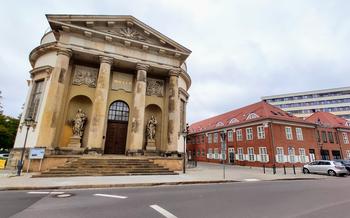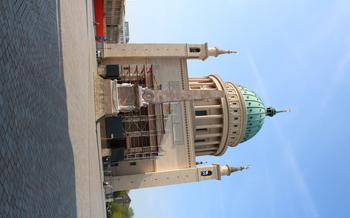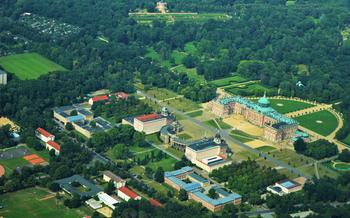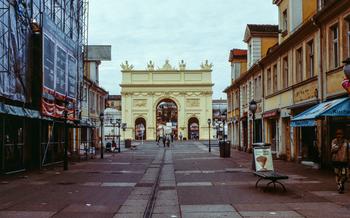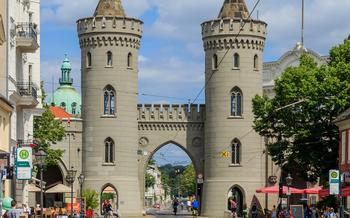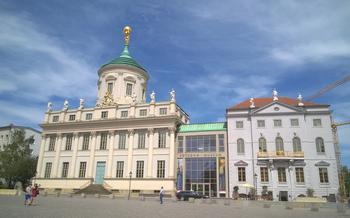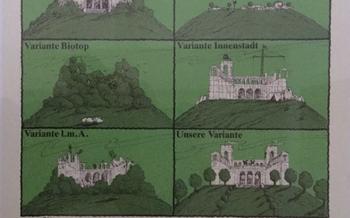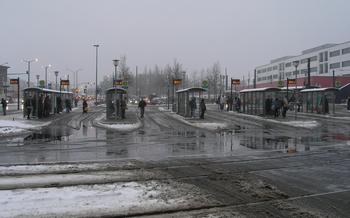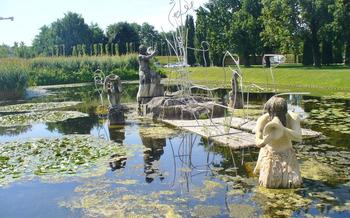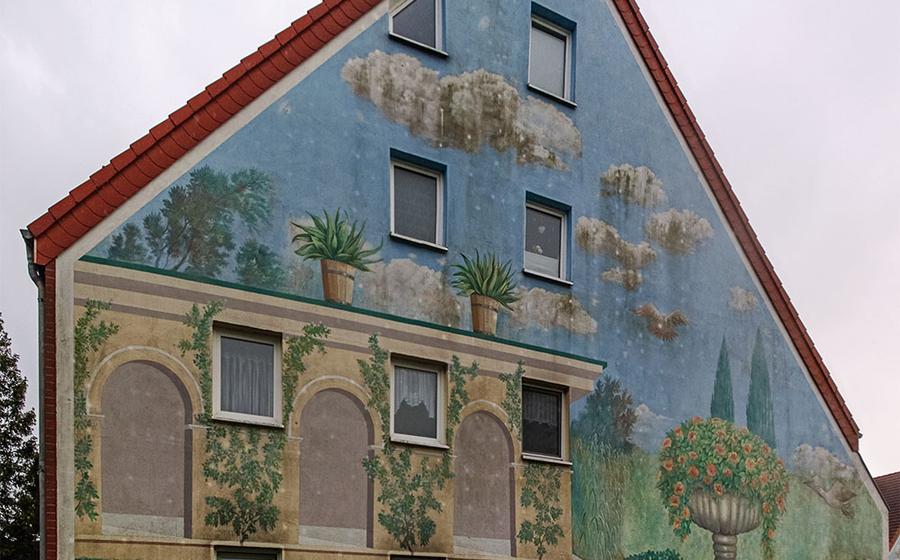
The Blue House (Blaues Haus)
- The Blue House in Potsdam
- History of the Blue House
- Architecture of the Blue House
- Current Use of the Blue House
- Insider Tip
- How to Get to the Blue House
- Exploring the Blue House
- Historical Context
- Exhibits and Collections
- Educational Programs
- Guided Tours
- Special Events
The Blue House in Potsdam
The Blue House (Blaues Haus) is a captivating historical landmark situated in the heart of Potsdam, Germany. Steeped in rich history, the building dates back to the 18th century and served as the residence of prominent figures during the Prussian and German empires. With its striking blue exterior and unique architectural features, it stands out as an iconic symbol of Potsdam's rich cultural heritage. Today, the Blue House serves as a vibrant cultural center, hosting exhibitions, events, and educational programs that celebrate Potsdam's past and present.
History of the Blue House
The Blue House stands as a testament to the rich history of Potsdam. Constructed in 1755, it initially served as a private residence for the wealthy merchant, Johann Heinrich Wegener. The building's striking blue exterior, a distinctive feature that has earned it its name, was added in the early 19th century. Over the years, the Blue House has witnessed numerous ownership changes, housing prominent figures from different walks of life. Notable residents included Prussian officers, merchants, and even the renowned artist, Carl Blechen, who resided in the building during the 1830s. Throughout its existence, the Blue House has remained inextricably linked to the cultural and historical tapestry of Potsdam, mirroring the city's evolution over time.
Architecture of the Blue House
The Blue House stands out for its unique design elements, blending various architectural styles. Its striking blue facade, a rarity in Potsdam's cityscape, instantly captures the attention of visitors. The building's intricate details and ornamentation showcase the craftsmanship and artistic vision of its creators.
The Blue House's architecture is a testament to the eclectic styles prevalent in the 18th century. While its overall structure adheres to the Baroque style, it incorporates elements of Rococo and Neoclassicism. The rounded corners and elaborate window frames are characteristic of Baroque architecture, while the delicate stucco decorations and pastel colors reflect the influence of Rococo. The building's symmetrical facade and emphasis on straight lines, however, hint at the emerging Neoclassical style.
Compared to other buildings in the area, the Blue House stands out for its vibrant color and ornate facade. While most buildings in Potsdam during the 18th century were constructed using traditional red bricks, the Blue House's unique blue hue sets it apart. The building's intricate carvings and sculptures further enhance its visual appeal, making it a true architectural gem in the city.
Current Use of the Blue House
Today, the Blue House serves as a vibrant cultural center, hosting a variety of exhibitions, events, and educational programs. The ground floor features a permanent exhibition dedicated to the history of the building and its former occupants, showcasing artifacts, documents, and interactive displays that bring the past to life. Temporary exhibitions on various historical and cultural topics are regularly held in the upper floors, offering visitors a chance to delve into diverse themes and perspectives.
The Blue House is also a popular venue for events and gatherings, ranging from intimate concerts and lectures to grand receptions and celebrations. Its elegant halls and spacious courtyard provide a unique and atmospheric setting for special occasions, creating lasting memories for guests. Whether you're interested in history, art, or simply seeking a unique cultural experience, the Blue House has something to offer everyone, making it a must-visit destination in Potsdam.
Insider Tip
Timing Your Visit: To fully appreciate the charm of the Blue House, aim to visit on a sunny day. The blue exterior radiates a vibrant hue under the warm sunlight, creating a picture-perfect moment. Even if the weather is gloomy, the Blue House stands out as a beacon of color, offering a delightful contrast to the surrounding cityscape.
Guided Tours: Delve deeper into the history and significance of the Blue House by joining a guided tour. These tours are typically offered on weekends and provide an informative and engaging narrative that brings the building's past to life. Reservations are recommended to secure your spot.
Hidden Gems: Just around the corner from the Blue House, discover the idyllic Dutch Quarter, a charming neighborhood known for its picturesque canals and historic buildings. Take a leisurely stroll along the cobblestone streets and admire the unique architecture, transporting you back in time.
Combining Attractions: Combine your visit to the Blue House with other nearby attractions to make the most of your time in Potsdam. The nearby Babelsberg Park offers stunning gardens, a beautiful lake, and the enchanting Babelsberg Palace. Alternatively, explore the historic center of Potsdam, with its grand palaces, charming squares, and captivating museums.
How to Get to the Blue House
The Blue House is conveniently located in the heart of Potsdam, making it easily accessible by various means of transportation. To fully immerse yourself in the city's charm, consider exploring Potsdam's historic center on foot. The Blue House is situated just a short walk from the Brandenburg Gate, the Sanssouci Palace, and other notable attractions.
For those arriving by public transportation, Potsdam's efficient bus network provides direct connections to the Blue House. Several bus lines stop nearby, including the 601, 605, and 69Alternatively, hop on the S-Bahn and disembark at the Potsdam Hauptbahnhof (main train station), which is a 15-minute walk from the Blue House.
If you prefer the convenience of driving, Potsdam offers ample parking options. Numerous public parking garages and street parking spaces are available in the vicinity of the Blue House. Please note that parking fees may apply, so be sure to check the signage before leaving your vehicle.
For visitors with limited mobility, the Blue House is wheelchair accessible. A ramp leading to the main entrance ensures easy access for those using wheelchairs or strollers. Additionally, the building features elevators, enabling visitors to explore all floors comfortably.
Exploring the Blue House
The Blue House is a treasure trove of historical artifacts, captivating exhibits, and interactive displays that provide a glimpse into the rich past of Potsdam. The interior of the building is organized into several rooms and galleries, each dedicated to a different aspect of the city's history or the building itself. Visitors can wander through the rooms at their own pace, admiring the exhibits and learning about the fascinating stories behind them.
One of the highlights of the Blue House is the collection of paintings and sculptures that depict scenes from Potsdam's history. These works of art offer a visual journey through the city's transformation from a small village to a bustling metropolis. Visitors can also view artifacts from the city's industrial past, including machinery, tools, and products that were once produced in Potsdam's factories.
For those interested in hands-on experiences, the Blue House offers a variety of interactive exhibits that allow visitors to engage with the city's history in a more tactile way. These exhibits include a replica of a medieval printing press, where visitors can try their hand at printing their own documents, and a model of the city's water supply system, which demonstrates how water was transported to Potsdam's residents in the past.
A typical visit to the Blue House lasts about an hour to an hour and a half, depending on the visitor's level of interest and the number of exhibits they wish to explore. However, visitors are welcome to stay longer and soak up the atmosphere of this historic building.
Historical Context
Potsdam, the capital of the German state of Brandenburg, has a rich and storied history. The city was founded in 993 AD and served as the residence of the Prussian kings and German emperors for centuries. During the 18th and 19th centuries, Potsdam experienced a period of rapid growth and development, becoming a major center of art, culture, and science. The Blue House, constructed in 1798, is a testament to this vibrant era in Potsdam's history.
The building was commissioned by King Frederick William II as a summer residence for his mistress, Wilhelmine Encke, Countess of Lichtenau. The king spared no expense in the construction of the Blue House, which was designed by renowned architect Carl Gotthard Langhans, who also designed the Brandenburg Gate in Berlin. The palace is a prime example of the neoclassical architectural style that was popular during the late 18th century, characterized by its symmetry, simplicity, and restrained ornamentation.
The Blue House played a significant role in Potsdam's history. It was a frequent gathering place for the Prussian court and hosted numerous lavish parties and receptions. The building also served as a venue for important diplomatic negotiations and political meetings. In the 19th century, the Blue House was briefly occupied by Napoleon Bonaparte during his invasion of Prussia.
After the fall of the German Empire in 1918, the Blue House was converted into a museum. Today, it is a popular tourist attraction that offers visitors a glimpse into the opulent lifestyle of the Prussian monarchy. The museum's collection includes furniture, paintings, and other artifacts from the 18th and 19th centuries.
Exhibits and Collections
The Blue House in Potsdam boasts a rich collection of exhibits and artifacts that showcase the building's history and significance. Visitors can explore permanent and temporary exhibitions that delve into various aspects of the Blue House and its role in Potsdam's development.
Permanent exhibits include "The History of the Blue House," which traces the building's origins and its transformation over the centuries, and "The Blue House in the Prussian Court," which highlights the building's connection to the Prussian monarchy and its role in shaping Potsdam's urban landscape.
Temporary exhibitions showcase a diverse range of topics related to Potsdam's history, culture, and architecture. Past exhibitions have explored themes such as "Potsdam's Royal Gardens," "The Art of the Prussian Court," and "Women in Potsdam's History."
A highlight of the Blue House's collection is the "Potsdam Room," which features a stunning collection of furniture, artwork, and decorative objects that recreate the grandeur of a Prussian royal residence. Visitors can admire the intricate carvings, opulent fabrics, and exquisite porcelain that adorned the Blue House during its time as a royal palace.
Through its diverse exhibitions and collections, the Blue House offers visitors a captivating journey through Potsdam's rich history, providing insights into the lives of the Prussian monarchs, the building's architectural significance, and the city's cultural heritage.
Educational Programs
The Blue House offers a range of educational programs, workshops, and lectures that delve into the building's history, architecture, and cultural significance. These programs are designed for visitors of all ages and interests, providing an opportunity to learn more about the Blue House and its role in Potsdam's history.
One popular program is the "Blue House History Walk," which takes participants on a guided tour of the building, exploring its architectural features and sharing stories about its past residents and events. Another program, the "Architecture and Design Workshop," allows participants to explore the Blue House's unique architectural details and learn about the different styles that influenced its design.
For children and families, the Blue House offers interactive workshops and activities that make learning about history and architecture fun and engaging. These workshops often include hands-on activities, such as building models of the Blue House or creating their own architectural designs.
To book an educational program or reserve a spot, visitors can contact the Blue House directly or visit their website. Advance booking is recommended, especially for groups or larger classes.
Guided Tours
Visitors to the Blue House can enhance their experience by booking a guided tour. These tours, led by knowledgeable and passionate guides, provide an in-depth exploration of the building's history, architecture, and collections. Guided tours are available in multiple languages and cater to different interests, including general history, architectural details, and special exhibitions.
One of the most popular guided tours is the "Blue House Highlights Tour," which offers a comprehensive overview of the building's most significant features and artifacts. This tour typically lasts for 60-75 minutes and covers the history of the Blue House, its architectural significance, and some of the highlights of the permanent collection.
For those interested in a more in-depth exploration, the "Architecture and Design Tour" focuses on the unique architectural features of the Blue House, including its Neoclassical facade, intricate interior details, and the innovative use of materials. This tour is particularly suitable for architecture enthusiasts and students.
To book a guided tour, visitors can either reserve a spot online in advance or inquire at the Blue House information desk upon arrival. It is recommended to book tours in advance, especially during peak tourist season, to avoid disappointment. Guided tours typically have a small group size to ensure a personalized experience and allow for interaction with the guide.
Special Events
The Blue House is not just a historical landmark but also a vibrant cultural hub that hosts a variety of special events, concerts, and festivals throughout the year. These events celebrate the building's rich history, showcase local talent, and provide a unique opportunity to experience the Blue House in a different light.
One of the most popular events is the annual Blue House Music Festival, which takes place during the summer months. This festival features an eclectic lineup of local and international musicians performing in the courtyard of the Blue House. Visitors can enjoy live music, food, drinks, and the beautiful surroundings of the building.
Other special events include art exhibitions, historical reenactments, and educational workshops. The Blue House also hosts regular concerts, lectures, and film screenings, offering visitors a chance to learn more about the building's history and architecture.
To find out about upcoming events, check the Blue House's website or social media pages. Advance tickets are recommended for popular events, especially during the summer months.
Combining a visit to the Blue House with one of its special events is a great way to experience the building's unique atmosphere and to learn more about its history and cultural significance. Whether you're interested in music, art, history, or simply looking for a fun and unique experience, the Blue House has something to offer everyone.
